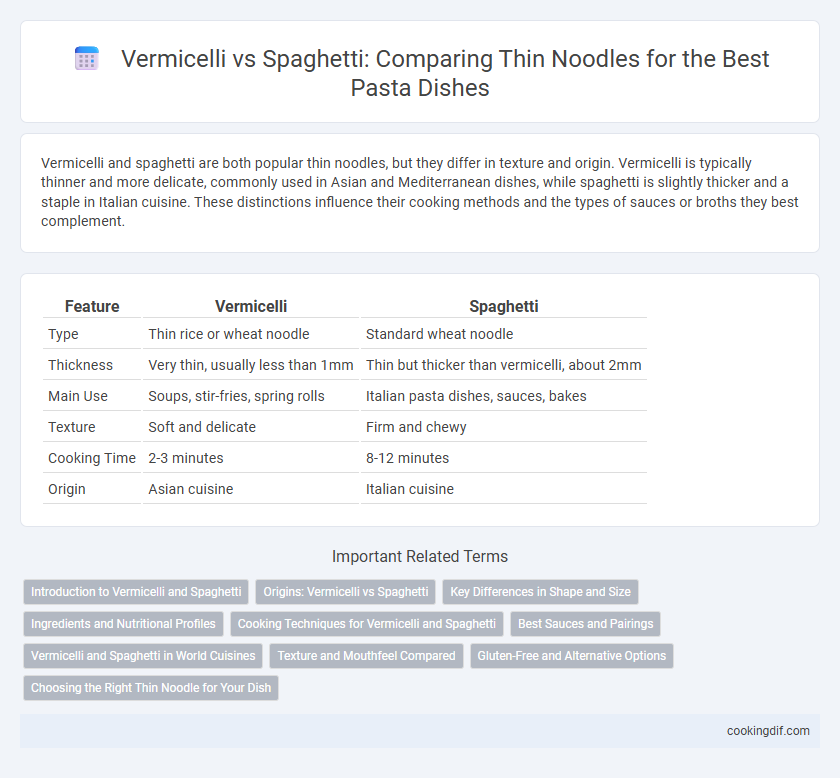Vermicelli and spaghetti are both popular thin noodles, but they differ in texture and origin. Vermicelli is typically thinner and more delicate, commonly used in Asian and Mediterranean dishes, while spaghetti is slightly thicker and a staple in Italian cuisine. These distinctions influence their cooking methods and the types of sauces or broths they best complement.
Table of Comparison
| Feature | Vermicelli | Spaghetti |
|---|---|---|
| Type | Thin rice or wheat noodle | Standard wheat noodle |
| Thickness | Very thin, usually less than 1mm | Thin but thicker than vermicelli, about 2mm |
| Main Use | Soups, stir-fries, spring rolls | Italian pasta dishes, sauces, bakes |
| Texture | Soft and delicate | Firm and chewy |
| Cooking Time | 2-3 minutes | 8-12 minutes |
| Origin | Asian cuisine | Italian cuisine |
Introduction to Vermicelli and Spaghetti
Vermicelli is a thin pasta traditionally made from rice or wheat flour, commonly used in Asian and Mediterranean cuisines, known for its delicate texture and quick cooking time. Spaghetti, a staple of Italian cuisine, is a long, cylindrical pasta made from durum wheat semolina, typically thicker and denser than vermicelli. Both noodles serve as versatile foundations for a variety of dishes, with vermicelli favored in stir-fries and soups, while spaghetti is predominantly paired with tomato-based sauces.
Origins: Vermicelli vs Spaghetti
Vermicelli originates from Asian and Middle Eastern cuisines, where it is traditionally used in soups and stir-fries, characterized by its extremely thin and delicate strands. Spaghetti, rooted in Italian culinary tradition, is a staple pasta made from durum wheat semolina, known for its slightly thicker and more robust texture. Both noodles serve distinct culinary purposes, reflecting their cultural origins and flavor profiles.
Key Differences in Shape and Size
Vermicelli noodles are typically thinner and more delicate than spaghetti, measuring about 1 millimeter in diameter compared to spaghetti's 2 millimeters. Vermicelli often has a round or slightly oval cross-section, whereas spaghetti is uniformly cylindrical. These differences in shape and size affect cooking time and texture, with vermicelli cooking faster and offering a lighter mouthfeel compared to the firmer bite of spaghetti.
Ingredients and Nutritional Profiles
Vermicelli is typically made from rice or mung bean starch, offering a gluten-free alternative with lower calories and carbohydrates compared to wheat-based spaghetti, which contains gluten and higher protein content. Spaghetti, composed primarily of semolina wheat, provides more fiber and essential minerals like iron and zinc but has a higher glycemic index than vermicelli. Nutritionally, vermicelli is often favored in gluten-free diets and lighter meals, while spaghetti supports energy needs with its denser nutrient profile.
Cooking Techniques for Vermicelli and Spaghetti
Vermicelli requires quick boiling in plenty of water for 2-3 minutes and is often soaked before cooking in Asian cuisines, ensuring a delicate texture that easily absorbs sauces. Spaghetti demands slightly longer boiling, typically 8-12 minutes in salted water, achieving an al dente firmness ideal for Italian dishes. Stirring techniques and timing are crucial for both noodles, with vermicelli's tendency to clump necessitating gentle separation and spaghetti benefiting from continuous stirring to prevent sticking.
Best Sauces and Pairings
Vermicelli pairs exceptionally well with light, fresh sauces such as garlic-infused olive oil, pesto, or tangy tomato-based sauces, enhancing its delicate texture without overpowering it. Spaghetti complements richer, heartier sauces like classic marinara, Bolognese, or creamy Alfredo, which cling well to its slightly thicker strands, balancing the flavors with its robust bite. Both thin noodles excel when paired with ingredients that match their texture and sauce absorption, making vermicelli ideal for Asian-inspired dishes and spaghetti suited for traditional Italian recipes.
Vermicelli and Spaghetti in World Cuisines
Vermicelli, a thin rice or wheat noodle, is a staple in Asian and Middle Eastern cuisines, often used in soups, stir-fries, and spring rolls, offering a delicate texture and quick cooking time. Spaghetti, a staple of Italian cuisine, is made from durum wheat semolina and is typically served with tomato-based sauces, meatballs, or seafood, providing a denser bite and ability to hold hearty sauces. Both noodles play unique roles in their respective culinary traditions, with vermicelli favored for light and broth-based dishes, while spaghetti complements robust, sauce-rich meals.
Texture and Mouthfeel Compared
Vermicelli features a delicate, fine texture that softens quickly when cooked, delivering a smooth and light mouthfeel ideal for broths and stir-fries. Spaghetti, while similarly thin, maintains a firmer bite with a slightly denser texture, providing a more substantial chew that suits thicker sauces and hearty dishes. The contrast in their mouthfeel makes vermicelli preferable for silky, tender noodle experiences, whereas spaghetti offers a satisfying al dente resilience.
Gluten-Free and Alternative Options
Vermicelli and spaghetti differ significantly in gluten content, with traditional vermicelli often made from rice or mung bean starch, making it naturally gluten-free and suitable for those with celiac disease or gluten intolerance. Spaghetti, typically crafted from durum wheat, contains gluten but can be substituted with gluten-free varieties using ingredients like rice flour, corn, or quinoa. For thin noodle alternatives, exploring rice vermicelli or gluten-free spaghetti options provides versatile choices for gluten-sensitive diets without compromising texture or taste.
Choosing the Right Thin Noodle for Your Dish
Vermicelli, often made from rice or mung bean starch, offers a delicate, translucent texture ideal for light Asian dishes and soups, while spaghetti, a wheat-based pasta, provides a firmer bite suited to hearty Italian sauces. Choosing the right thin noodle depends on the dish's flavor profile and cooking method; vermicelli absorbs broth flavors quickly, making it perfect for stir-fries and pho, whereas spaghetti maintains structure under rich tomato or cream sauces. Understanding these differences ensures the optimal noodle complements your recipe's texture and taste.
Vermicelli vs spaghetti for thin noodle comparisons Infographic

 cookingdif.com
cookingdif.com